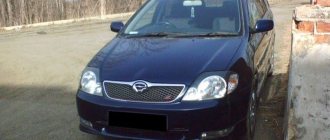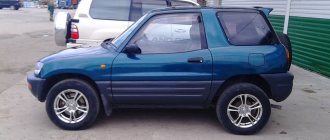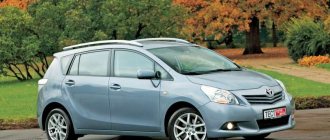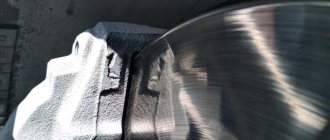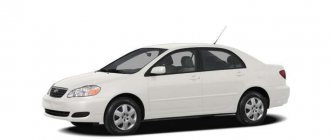Transmission
The all-wheel drive system is reliable. During the operation of the Toyota RAV4, you mainly have to deal with the howling of the driveshaft outboard bearing and the appearance of play in the cardan crosspieces. The cost of a new cross is about 600 rubles, and replacement work costs another 2.5-3 thousand rubles.
The crossover was equipped with two gearboxes: a 5-speed manual and a 4-speed automatic. The clutch of a manual transmission lasts more than 150-200 thousand km. With a mileage of more than 200-250 thousand km, the input shaft bearing may become noisy. On later runs, 5th gear is knocked out.
| Toyota RAV4 (2003-2006) |
“Avtomat” received several chronic diseases. On cars of 2000-2003, after 130-150 thousand km, the microcircuits on the ECU board burn out, which is why shocks (impacts) appear when moving from second to third and after engaging reverse gear. The problem unit is located behind the glove compartment, the cost of re-soldering is about 4-5 thousand rubles. It is better not to delay repairs, as driving with jolts leads to failure of the box itself. A complete repair of the box will require about 60 thousand rubles.
After 200-250 thousand km, a hum may appear when driving in first gear. Over time, the seats of the satellite axes break, and the “planetary” begins to hum. There is no cure for this disease; the owners can only ride to victory.
It is also common to see the automatic transmission pump bushing turning, which begins to rotate or tear the gearbox seal, which soon begins to leak. The cost of a new pump is about 5-7 thousand rubles.
Review of Toyota RAV-4 2.0 16v VVT-i 4WD (2002)
The children went to school, autumn was beginning outside the window...
Once again I woke up at eight in the morning... eight... But six months ago I calmly woke up at ten o’clock, drank my morning coffee, leisurely watched the news, took a shower and left for work in high spirits. Everything changed when my wife started going to work. Now we got up at 8 am, there was a frantic struggle for a place under the tap, a quick breakfast and a drive across the city taking my wife to work. I myself came to the office earlier than everyone else and, out of habit, left later than everyone else. This had to end sometime.
This is how thoughts about buying a car for my wife appeared. In fact, in her youth she was still a driver, making crazy runs around the South Coast and Odessa. Now I just persuaded her to buy her own car.
She chose it herself. We drove around the city, she said - I want one, I said - no. It turned out that the wife has good taste; she rarely managed to point out a car for less than $100,000. Then we sat for quite a long time at a romantic table with a laptop on our laps in the light of candles with a bottle of our favorite sake and still chose what to buy.
The torment of choice was put to an end when the wife noticed a short RAV-4 on the roads of the city, and she became very serious, so much so that she had to look for it in an emergency.
In general, I am on the side of people who prefer to buy used cars, even when there is finance. opportunities to buy new ones. My Merc, less than 5 years old, with a catalog price of 40,000 euros in 2010, cost $18,000 in 2010, although from the point of view of consumer qualities, he did not notice any significant differences in the new car (I drove it with a friend). Well, that's it, a lyrical digression.
They searched for the car according to ancient tradition in auto houses in Germany. Moreover, it turned out that the car was quite rare and the choice was essentially from 5 copies. We started with more expensive copies, and ended up buying the cheapest one. Pricing is a little unclear, because... It turned out to be a very new car.
So, after making several clever pacts, waiting about a month and finally she is in our yard. Mileage 107,000 km, automatic, 150 ponies, born in 2002, Japanese by birth, German by nature. It cost $12,500-13,000 turnkey in 2009.
The first trip through the yards left me in some delight. With its miniscule mass, the car seemed to shoot out at the slightest press on the gas pedal. Wide wheels - 235, short wheelbase, low weight with 150 horses - it turned out to be a crazy little box. Precisely the box puppy, because The trunk is a very nominal concept in this car, unless you put a bag with a laptop. Although it was spacious to sit in the back due to the fact that the seats easily move back and recline almost to the rear door. Everyone climbed into the back seat and was surprised at how comfortable it was. And it’s convenient because there are chic protrusions on the sides that you can rest your hand on. True, more than 2 people will not fit there, or 2 people and a dwarf.
Thus began everyday life in Moscow. I only refueled with 95 gasoline, although at almost every gas station the gas stations immediately offered 92. Maybe they were right, but since it says 95 on the hatch, it means 95. The car suffered moderately from appetite in the fall - about 12-13 liters, in winter there were already other numbers - 15-16 as the least. Looking ahead on the highway, I’ll say that it’s about 10 liters per 100 km at a speed of 120 km/h. In general, not 1300 km on one tank like on my car.
Sometimes there was a time that I forgot about the existence of the car. The wife confidently covered the learned route to work and back and learned a new route to the store. But on weekends, if I had to go somewhere, the RAV-4 was always chosen. I don’t know why, but I felt drawn to ride it. We are a family of only 2 people, so it was enough for us. We also drove it to our hometown of Minsk. Although this only happened a couple of times. The biggest, no, not the HUGE drawback of the RAV-4 is its sound insulation. At a speed of 90 km/h I already had to scream. Probably due to the fact that the base is short, the arches are huge, the wind was blowing heavily there. Plus a 4-speed gearbox and now at a speed of 100 km/h the engine was spinning, producing more than 3000 rpm, the noise from under the wheels intensified many times over, and also the aerodynamics of a stool flying into the distance... So we drove almost silently the whole way and 8 hours later, having already turned off the engine, we drove the entire next night (figuratively, of course). City car up to 80 km/h without options.
There is another huge drawback. Heavy doors and a seat belt about a meter from the seat. By the time you reach it, you seem to be fastening yourself, but it’s not like a seat belt, but a rope, which was practiced during executions, only there is not enough soap. Compresses the chest thoroughly. And when you go out and close the door, with a 90% probability the belt gets pinched in the opening. I’ve already done this and that, but you still forget about him.
In this manner we drove more than 10,000 km. The car did not cause any problems. Unless all my friends, if I was driving, shouted in one voice: “And isn’t it weird for you to drive a woman’s car?!” Probably this is really more of a woman’s car, but somehow I don’t care about the flashlight, I didn’t start tinting my eyelids because of this.
At maintenance 120,000, they changed the oil and filter as required, everywhere a person could reach. And in the box, and in the transfer case, and somewhere else, I forgot where. After that we drove almost 7000 more and again not a single problem. The suspension was generally all original. I don’t even know what to complain about, nothing broke at all, even the light bulbs didn’t burn out. Probably also because the suspension is designed for a heavier 4-door version, but here the car is significantly lighter (that’s not why the light bulbs didn’t burn out, it’s also due to the suspension).
I really like the warm-up feature in the car. It’s not like, for example, a Mercedes: you start it, the revolutions drop to 750 and it sits there all day, the temperature gauge at -10 outside doesn’t even budge. You sit in the cabin, chatter your teeth like a wolf and then steer like in the early nineties with four fingers. Toyota is another matter. When you start it, it initially holds 1800 rpm, reducing them in proportion to warming up. After 3-4 minutes, the oil temperature is already approaching 90 degrees. In winter it’s absolutely a fairy tale.
Off-road performance is hardly very good. But as for snow and snowdrifts, this small one will give any SUV a head start. On its wide shovels with the weight of a chicken, it simply does not fall deep into the snow and, with its ground clearance of 20 cm, overcomes the snowy expanses in one go. She served as our pioneer to the dacha, followed by more experienced women. By the way, according to ancient tradition, no one ever cleaned the road to the dacha, and after a snowfall the car was a great help, although it has practically no electronic assistants, except for ABS. ABS works very slowly, i.e. It would be better if it didn’t exist, because... it lengthens the braking distance very well. I don’t know why, but almost always when it is triggered, the car stupidly floats on, but with a crunch. Therefore, you have to slow down in advance anyway.
But my Lady (this is not about the car) is no longer afraid of blind spots (again, the term is not from the “stalker” series). They simply don’t exist at RAF. You drive as if in a glass bell, visibility is one hundred hundred points, only the spare tire hanging on the door in the back is a little in the way. I’m tempted to airbrush it from the cover of the movie “Dawn of the Dead” (there’s such a kind man on the cover). But so far it has not been possible to break through the defense.
To summarize in principle:
During the entire period of ownership (more than 20,000 km) nothing broke at all.
It started at both -30 and +40 without any problems.
She makes noise like a mother-in-law to her son-in-law when living together for 10 years under the same roof.
Damn seat belt, at least cut it off.
Driving qualities are on par (especially when in overdrive mode).
The machine is ancient and very reliable in its operation.
There was no glitch with the ABU, as described on specialized forums.
In general, I recommend it. The car is definitely worth the money.
Chassis
| Toyota RAV4 (2000-2003) |
The Toyota RAV4 suspension is relatively strong. Front stabilizer bushings last more than 50-80 thousand km (100-200 rubles), struts - more than 80-100 thousand km (about 900 rubles for the original). Bushings and struts of the rear stabilizer last more than 100-150 thousand km.
Front and rear shock absorbers may require replacement after 100-150 thousand km. The front shock absorber strut will cost 3-5 thousand rubles, the rear one – 1-2 thousand rubles. The front support bearing lasts more than 120-150 thousand km. The front ball joints will need to be replaced after 140-180 thousand km (600 rubles).
After 150-200 thousand km, the suspension arms will most likely need to be replaced. The cost of one lever is 5-8 thousand rubles. The cost of a complete overhaul of the front suspension will be about 50 thousand rubles, the rear - about 30 thousand rubles. When replacing suspension arms or adjusting wheel alignment, you often have to deal with sticking of the eccentrics. The use of a grinder allows you to speed up the process.
Front and rear wheel bearings last more than 130-180 thousand km. The rear hub is replaced as an assembly - about 8 thousand rubles for the original, the design of the front one allows you to replace only the bearing, costing 2 thousand rubles for the original.
After 100 thousand km, a knock in the front suspension can be caused by wear of the silent blocks securing the steering rack. A set of new rubber bands costs about 1,500 rubles. Steering rack leakage is also common. The cost of a repair kit for oil seals is about 2 thousand rubles, a new rack is about 30 thousand rubles.
Over time, brake calipers become sour and begin to jam (usually the rear ones). After replacing brake pads and discs, owners often talk about the brake pedal. Replacing the brake master cylinder does not correct the situation. The reason for this behavior is still unclear. After several trips, the frightening symptoms go away and the pedal begins to behave correctly.
Toyota RAV4 2.0, 2.2, 2.4, 2.5 fuel consumption per 100 km. 1st, 2nd, 3rd, 4th generations
Hello, RAV4 owners! I have a 2.2 diesel 4th generation 2014, Japanese assembly. I bought it new at a Toyota dealership. With the permission of the Toyota dealership, I chipped the engine since the purchase (increased the engine power with a separate chip block). I bought and installed the chip from them. Hydraulic automatic transmission - 6 steps. The car is playful in all modes. Everything in the car is fine. There are little things, but they are not important enough to write about. I drove about 42,000 km on the Rava in 4.5 years. A couple of times the box glitch came out: “CHECK AWD”! This malfunction occurred 2 times a year later (in the 2nd and 3rd years of the car’s life), but this glitch itself went away! The second time I had to disconnect the negative terminal from the battery! And everything passed! At the salon they said: what happens! And that there are no traces left in the processor if you remove the battery terminal. Either there were no problems, and after the glitch they checked the car for a test drive and said that everything was ok! At the service center they did diagnostics on the entire car - they found no problems! Because of this, I extended the full warranty of the car from 3 to 5 years - paying 38,000 rubles! I'm discussing with the dealer. I watched a video from one smart blogger: they say that the automatic transmission, and specifically with a 2.2 diesel engine, is unimportant and if you start abruptly and drive aggressively, it breaks down by 50-80 thousand km or a little later! I drive mostly calmly, but sometimes I rarely need to move sharply or overtake someone faster on the highway. But this is not so common. The blogger says that the 2.2 diesel box is not designed for a torque of 340 nm! And the gearbox is 4 - 180 hp (gasoline 2.5, automatic, 233 nm) - then the same 6-mortar, but this one is a little different and more advanced and it’s problem-free! Moreover, it is gasoline (the speed of a gasoline engine is higher than that of a diesel engine), but the torque of a gasoline engine (2.5) is much lower! Someone can answer - were there any problems with the automatic transmission (6 speeds) on the 2.2 diesel? So far, thank God, apart from the computer glitches of the car with the box (see above), I have had no problems with the whole car! Don’t believe anyone, diesel consumption on the highway (I drove 1500 km from Moscow on September 10, it was hot), then the total consumption on the highway is 7.4 liters per 100 km, especially since there are sections of 130 and 110 and 100 km/h, then I drove at least 90 and within the permissible speed limits on the highway! This is the total expense. And now on the highway the consumption is 7.2 l/100 km. In the city in traffic jams the consumption is up to 12 liters per 100 km. I asked the dealer if there were any problems with the diesel RAV? They answered (in 2015-2016) that the cars had been serviced for 180 thousand km, but there were no problems! Anyone who has experience with higher mileage, please respond - were there any problems with the automatic transmission on the diesel RAV 4 - 2014? Thanks in advance.
Other problems and malfunctions
Body iron, if not repaired after an accident, is not prone to corrosion. On RAV4s older than 8-10 years, the “glasses” of the headlights turn yellow, and the lighting efficiency decreases.
On older cars, the washer motor often fails. The cost of a new tank assembled with a motor is about 2-3 thousand rubles.
| Toyota RAV4 (2003-2006) |
Sometimes the door locks stop working. One of the reasons is broken wiring in the protective corrugation of the door electrical harness. For the same reason, the power window may stop working. But more often the problem with locks lies in the lock motor due to the failure of the varistor - a variable resistor. After removing the “dead” resistor, the lock’s functionality is restored.
Water in the cabin may appear due to a clogged air conditioner drain or sunroof (if equipped). If water sits for a long time, the floor begins to corrode. Corrosion often affects the seat mounting ears, which looks unsightly.
There are no systematic problems with the climate control system or electrical system.


